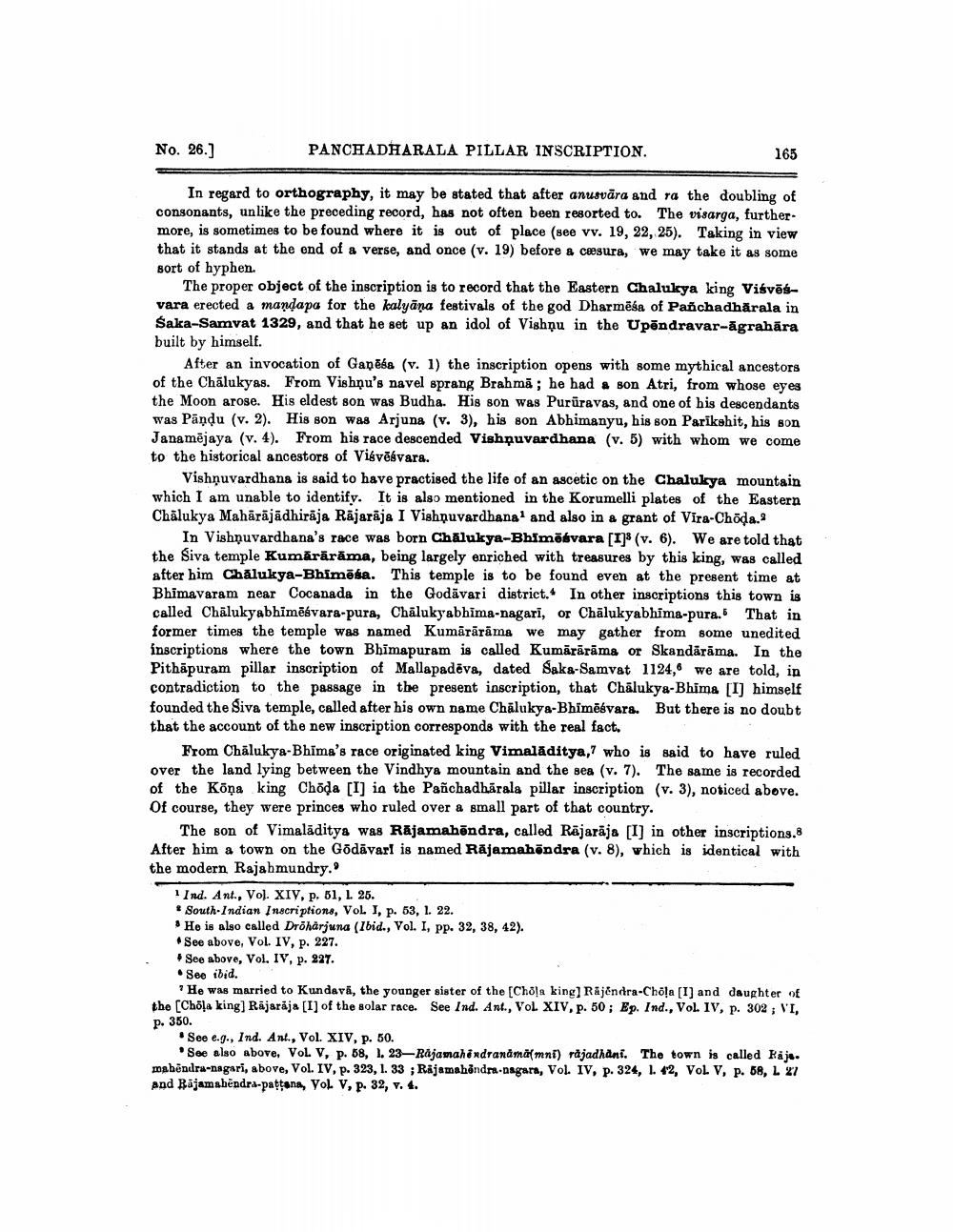________________
No. 26.]
PANCHADHARALA PILLAR INSCRIPTION
165
In regard to orthography, it may be stated that after anusvāra and ra the doubling of consonants, unlike the preceding record, has not often been resorted to. The visarga, further more, is sometimes to be found where it is out of place (see vv. 19, 22, 25). Taking in view that it stands at the end of a verse, and once (v. 19) before & cæsura, we may take it as some sort of hyphen.
The proper object of the inscription is to record that the Eastern Chalukya king Visvēsvara erected a mandapa for the kalyāna festivals of the god Dharmēsa of Panchadhārala in Saka-Samvat 1329, and that he set up an idol of Vishnu in the Upēndravar-āgrahāra built by himself.
After an invocation of Ganesa (v. 1) the inscription opens with some mythical ancestors of the Chalukyas. From Vishnu's navel sprang Brahmă; he had & son Atri, from whose eyes the Moon arose. His eldest son was Budha. His son was Pururavas, and one of his descendants was Pandu (v. 2). His son was Arjuna (v. 3), his son Abhimanyu, his son Parikshit, his son Janamējaya (v.4). From his race descended Vishnuvardhana (v. 5) with whom we come to the historical ancestors of Visvökvara.
Vishnuvardhana is said to have practised the life of an ascetic on the Chalukya mountain which I am unable to identify. It is also mentioned in the Korumelli plates of the Eastern Chalukya Mahārājādhiraja Rajaraja I Vishnuvardhana and also in & grant of Vira-Choda.
In Vishnuvardhana's race was born Chalukya-Bhimõbvara [1] (v. 6). We are told that the Siva temple Kumārārāma, being largely enriched with treasures by this king, was called after him Chalukya-Bhimēša. This temple is to be found even at the present time at Bhimavaram near Cocanada in the Godāvari district. In other inscriptions this town is called Chalukyabhimēsvara-pura, Chalukyabhima-nagari, or Chālukyabhima-pura. That in former times the temple was named Kumārārāma we may gather from some unedited inscriptions where the town Bhimapuram is called Kumārārāma or Skandārāma. In the Pithāpuram pillar inscription of Mallapadēva, dated Saks-Samvat 1124, we are told, in contradiction to the passage in the present inscription, that Chalukya-Bhima [I] himself founded the Siva temple, called after his own name Chalukya-Bhimēsvars. But there is no doubt that the account of the new inscription corresponds with the real fact.
From Chalukya-Bhima's race originated king Vimalăditya, who is said to have ruled over the land lying between the Vindhya mountain and the sea (v. 7). The same is recorded of the Köna king Choda [I] in the Pañchadhárala pillar inscription (v. 3), noticed above. Of course, they were princes who ruled over a small part of that country.
The son of Vimalāditya Was Rajamahöndra, called Räjarājs [I] in other inscriptions.8 After him a town on the Godāvarl is named Rājamahöndra (v. 8), which is identical with the modern Rajahmundry.
1 Ind. Ant., Vol. XIV, p. 51, L. 25. * South Indian Inscriptions, VOL I, p. 53, 1. 22. . He is also called Dröharjuna (Ibid., Vol. I, pp. 32, 38, 42). See above, Vol. IV, p. 227. See above, Vol. IV, p. 227. See ibid.
He was married to Kundavā, the younger sister of the Chola king) Rajendra-Chola (I) and daughter of the (Chöļa king) Rajaraja [I] of the solar race. See Ind. Ant., VOL XIV, p. 50; Ep. Ind., VOL. IV, p. 302; VI, p. 350.
. See e.g., Ind. Ant., Vol. XIV, p. 50.
See also above, VOL V, p. 58, 1. 23-Rajamahendranämälmni) rajadhani. The town is called Raju. mahendra-nagari, above, Vol. IV, p. 323, 1. 33 ; Rajamahöndra-nagara, Vol. IV, p. 324, I. 42, VoL V, p. 58, L 27 and Bājamshendra-pattana, YOL V, p. 32, v. 4.




